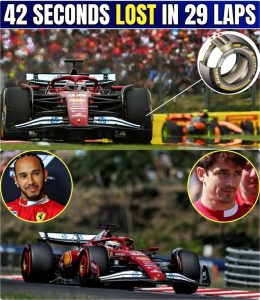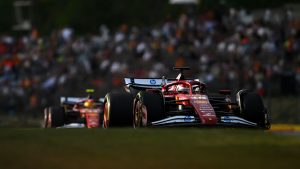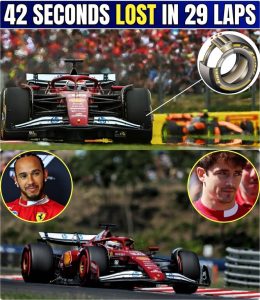The 2025 Hungarian Grand Prix was expected to be a showcase of Ferraris precision and pace, with Charles Leclerc starting from pole position and controlling the early stages of the race. For 40 laps, it appeared that the Scuderia had everything under control. Leclerc was executing a near-perfect drive, managing his tires well and keeping the chasing McLarens at bay. The atmosphere in the Ferrari garage was tense but confident, with victory seemingly within their grasp. However, by lap 41, everything changed, and the race unraveled in a manner that left fans, commentators, and even rival teams bewildered.
The turning point came after a sudden and unexpected call from the Ferrari pit wall. Leclerc was instructed to switch to a more conservative engine mode and alter his driving lines to reduce plank wearan issue that had been flagged internally but never clearly communicated to the driver during the earlier stages of the race. While such instructions are not unusual in Formula 1, the timing and abruptness of the decision caught both Leclerc and the viewers off guard. The result was an immediate drop in pace, which allowed Lando Norris and Oscar Piastri to close the gap within a matter of laps.

Further confusion arose when Ferrari simultaneously instructed Leclerc to raise his tire pressures during the next pit stop. This adjustment, intended to protect the cars underbody from excessive bouncing and to meet post-race legality checks, had an unintended consequence: reduced grip and increased tire degradation. With the track temperature soaring in Budapest, the higher pressures quickly caused the Ferrari to slide through corners, overheating the tires and forcing Leclerc into a defensive driving style that sapped his remaining speed.
Compounding the problem was a breakdown in communication between the pit wall and the cockpit. Engineers were focused on monitoring data and ensuring compliance with FIA regulations, but their messages to Leclerc lacked clarity. On several occasions, team radio exchanges revealed Leclerc seeking confirmation on strategy and tire management, only to receive vague or delayed responses. As Norris swept past on lap 48, it was evident that the race had slipped away. By the chequered flag, Leclerc trailed the McLaren driver by 42 secondsa staggering gap considering his earlier dominance.

Post-race analysis revealed that the plank wear issue had been developing since the second stint. Ferraris aggressive setup, designed to maximize aerodynamic performance, had left the car running lower to the ground, increasing the risk of breaching FIA regulations on plank thickness. The teams mid-race decision to adapt strategy was, in essence, a reactive measure to avoid potential disqualification. While technically justified, the execution and timing of these changes were widely criticized.
Former drivers and pundits were quick to weigh in. Its a classic case of Ferrari overcomplicating a winning position, remarked one ex-Formula 1 champion. You can manage technical risks without completely sacrificing race pace, but it requires clear planning and communicationboth of which were missing today.

Leclerc, for his part, remained diplomatic in post-race interviews but could not hide his disappointment. We had a very strong car today, and the first half of the race was exactly how we wanted it. Then, things changed very quickly. I trust the team made the call they thought was right, but its tough to accept when you feel youve lost a race we could have won, he said.
For Ferrari, the Hungarian GP will serve as a painful reminder of how quickly a promising race can turn into a strategic disaster. With the championship battle tightening, such missteps could prove costly. As the F1 calendar moves forward, the Scuderia will be under immense pressure to not only optimize their cars performance but also to restore the confidence of their driverand their fansafter one of the most baffling turnarounds of the season.
Leave a Reply